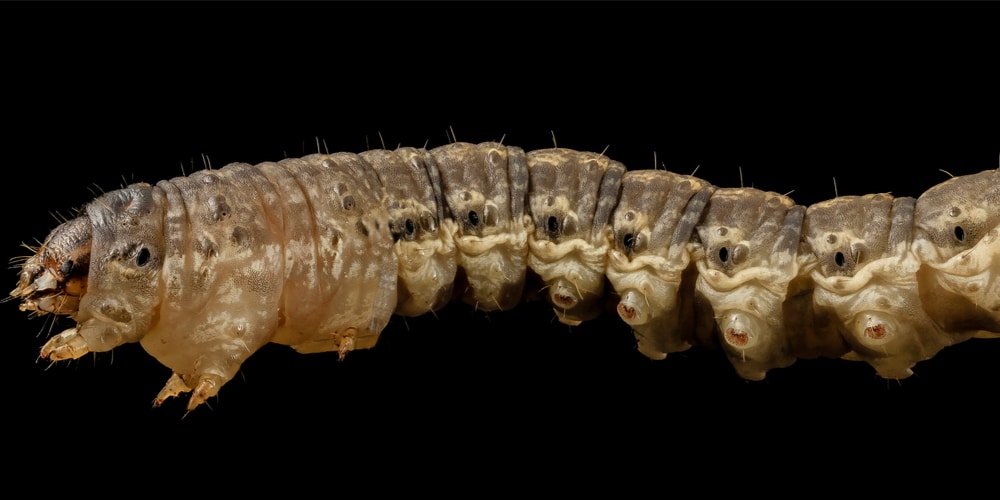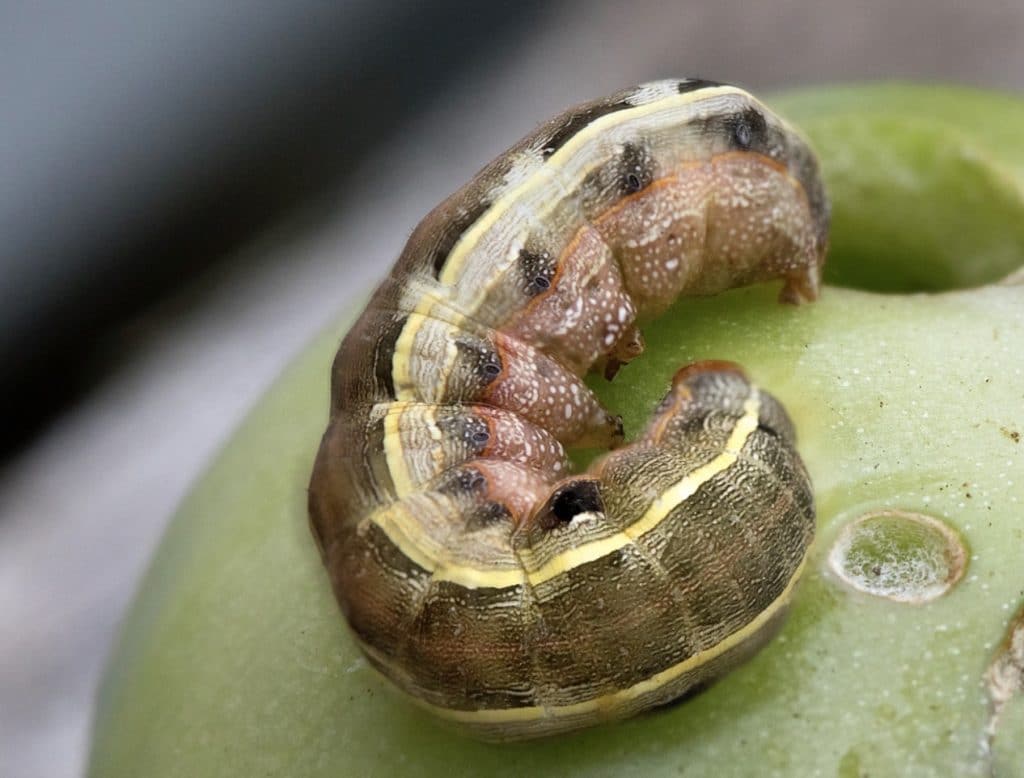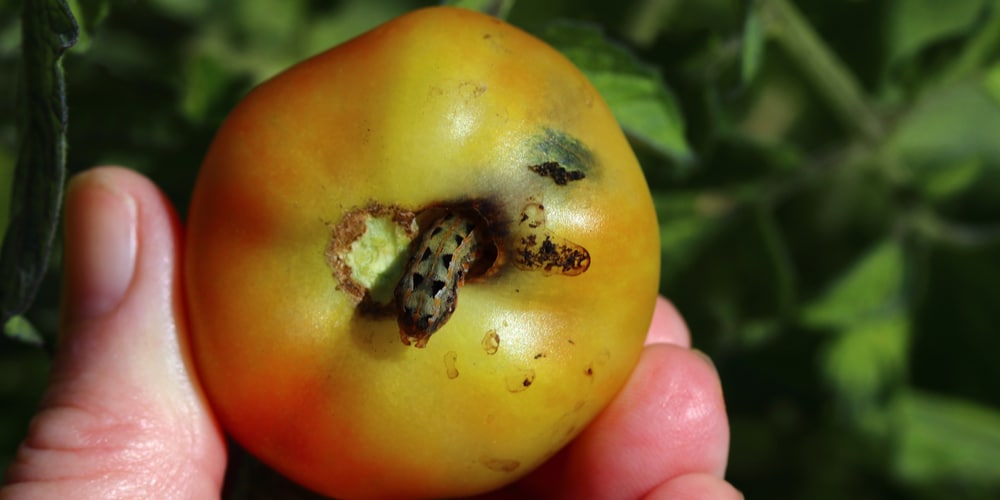Many common garden pests love to feed on tomato plants. If your plants are affected by black worms, you may be wondering what they are and how to get rid of them.
It’s essential to act fast, as an infestation of black worms can ruin your crop of tomatoes. Let’s look at the types of black worms on tomato plants and how to eliminate them.
What Kind of Worms are the Black Worms on Tomato Plants?
Many varieties of caterpillars are black or turn black at some point in their life cycle. Each caterpillar is distinctive, so it should be easily identifiable. Some caterpillars, such as cutworms, are hard to spot as they are nocturnal. Others, such as armyworms, leave a pattern on the tomato plants’ leaves. Here are the main types of black worms or caterpillars on tomato plants:
Black Cutworm

Black cutworms grow between one and two inches in length and feed on the leaves and fruit of tomato plants. These larvae curl up if you try to touch them and are nocturnal, so they can be challenging to spot. Black cutworms will hide in the soil and come out at night to eat plants.
Cutworms get their name due to their ability to cut through tomato plants’ stems, stalks, and fruit. They are most likely to affect young seedlings as they will eat growing stems and kill the young plants before they grow fruit. They also eat tomatoes on mature plants by cutting holes in the fruit.
Tomato Fruit Worms
Tomato fruit worms are actually tiny caterpillars rather than worms. They grow inside the tomato fruit and eventually turn into moths when they mature.
Tomato fruit worms start off life as a white caterpillar with a black head and hair. As they get older, they change color and become totally black with distinctive white markings on their sides.
Adult fruit moths lay eggs on tomato plant leaves during the night. Once the eggs hatch, the tiny caterpillars will attack a green tomato which is about to ripen. They will stay inside the tomato until they grow larger and then attach themselves to the soil beneath the plant and make a cocoon. They will remain in the cocoon for two weeks before emerging as a moth.
Armyworms
One of the most common types of caterpillar to infest tomato plants is known as the black worm. These caterpillars feed on tomato plant leaves and stems, as well as the surface of the fruit. They are notorious for attacking tomatoes in packs and can quickly ruin your crop.
How to Get Rid of Black Worms on Tomato Plants?
If you recognize the insect on your caterpillars from the above description, it’s time to take action. Here are some ways you can control black worms on tomato plants:
Hand-Pick Caterpillars and Eggs
One of the best ways to eliminate black worms on tomato plants is to pick off any visible caterpillars and eggs. You may like to wear a glove when doing this job.
To kill the larvae, mix a dish soap and water solution and drop the larvae into the mixture. You should also be aware that some insect’s eggs are so small that they are impossible to spot. You can wipe your tomato plant leaves with a damp cloth to get rid of these.
After attempting to remove eggs, you should keep a close eye on your plants and repeat the process if you notice any lingering black worms.
Encourage Helpful Predators
Natural pest control methods are always better than using pesticides. Encourage beneficial insects and birds into your yard as these will eat the black worms on your tomato plants.
Plow Your Soil
Fruit worms and cutworms overwinter by hiding in the soil throughout the winter months. If you’ve seen signs of these insects in the ground, it’s a good idea to regularly plow your soil in the fall and winter to expose them.
Once the growing season is over, clear away any debris such as dried leaves and weeds from the soil. Don’t compost these as they may contain black worms. You can then till the soil to stir up the caterpillars and allow air to circulate. This will allow birds to eat the caterpillars.
If you have any chickens, you can also allow them to eat the uncovered larvae. This will help control pests and will mean you’ll be less likely to have a black worm infestation in the next growing season.
Create a Homemade Pesticide
Alternatively, you may like to make a homemade, organic pesticide that can be used to control bests. Spray the following on your soil:
- Tobacco juice- Cigarette butts can be soaked in water for a couple of days. The solution can then be strained and poured around your tomato plants to deter insects.
- Garlic solution- Make a garlic solution by crushing two garlic bulbs and soaking them in water for twelve hours. Add half a cup. of vegetable oil, some ground pepper, and one teaspoon of dish soap.
- Vinegar solution- Vinegar is a natural insecticide as its acidic and can repel insects. Mix a tablespoon of vinegar with two liters of water.
Pesticides
If your tomato plants are heavily infested, you may need to use a pesticide to eliminate the black worms. There are many products on the market that will help get rid of caterpillars.
- Bacillus Thuringiensis (Bt)- BT is a biological insecticide that adds bacteria to the soil that’s toxic to black worms and other caterpillars. This insecticide will attack the caterpillar’s digestive system and works best on young larvae. You can get it at any local garden shop, or Amazon.
- Neem oil– Neem oil has many uses and is very effective as an insecticide. It’s an organic product that can also be used as a fungicide and miticide.
- Spinosad– Spinosad is a biological insecticide containing soil bacterium that kills black worms that affect tomatoes. The insect larvae or caterpillars must ingest this solution for it to work.
Related:
Conclusion
As you can see, there are a few different types of black worms and caterpillars that affect tomato plants. Some are sneaky, and you may not be able to spot them during the day, while others are tiny. You’ll need to carefully observe your tomato plants to determine what type of pest you’re dealing with and then take appropriate action to get rid of them.


